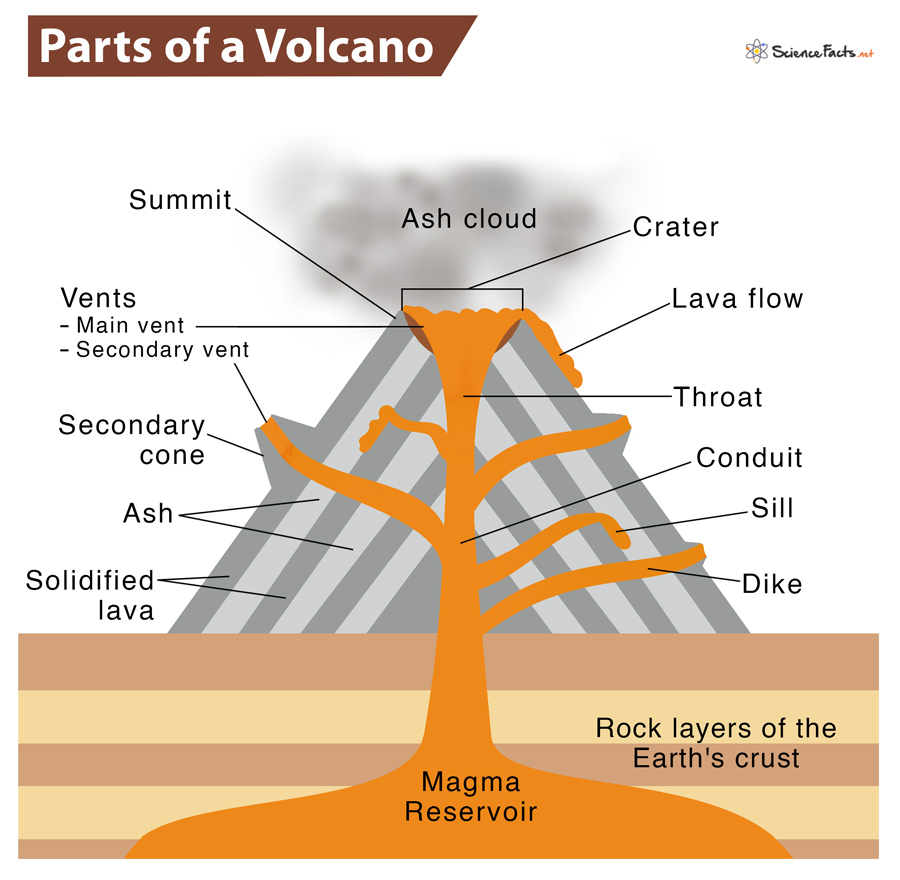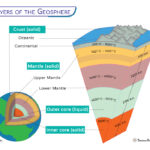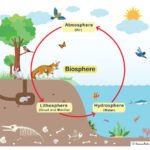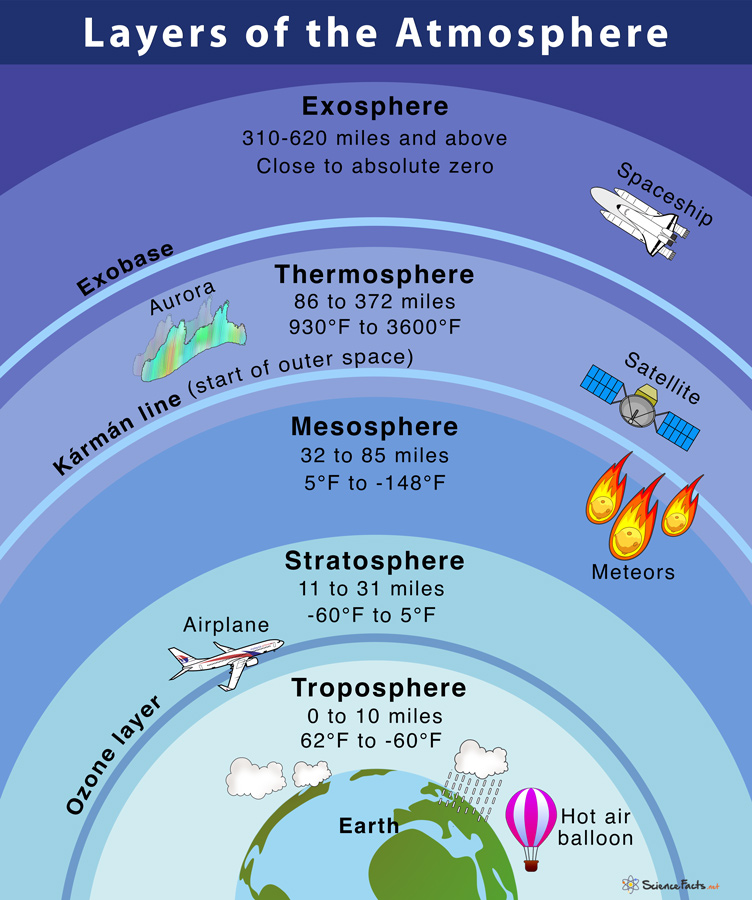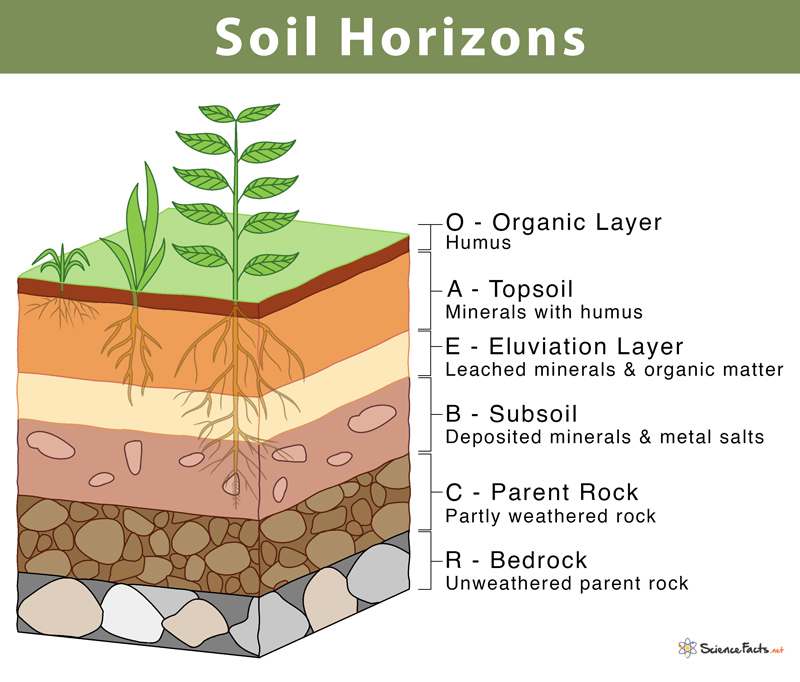Parts of a Volcano
Volcanos are massive openings or vents on the Earth’s surface. Hot lava, gases, ash, rock fragments, and toxic fumes erupt from them. They are the most potent internal forces of nature that have existed for a long time on Earth. Originating deep within the crust, they have a lasting impression on the landscape. Volcanoes have created almost 80 percent of our planet’s surface, making the foundation on which lives thrive.
On Earth, volcanoes are mostly found where tectonic plates are diverging or converging, mostly underwater. Some volcanic eruptions are mild and effusive, while others are highly destructive.
What are the Different Parts of a Volcano
Volcanoes can be of different shapes and sizes, but all contain some basic parts. The essential parts of a typical volcano are: 1) magma chamber, 2) lava, 3) primary vent, 4) throat, 5) conduit, 6) crater, 7) summit, 8) secondary vent, 9) secondary cone, 10) lava flow, and 11) ash cloud.
1) Magma Reservoir
It is a large pool of molten rock found underneath the Earth’s crust. The molten rock remains under extreme pressure, which causes the surrounding rock to crack and fracture, creating an outflow of the magma. Being less dense than the surrounding mantle allows the magma to seep up to the surface through the cracks.
When the magma reaches the surface, it results in a volcanic eruption. Most magma reservoirs are found close to the Earth’s surface, usually between 1 km and 10 km. Also, being a part of the Earth’s crust ranges between 5 and 70 km of the crust.
2) Lava
It is the molten rock or magma that erupts from the volcano. The extreme heat of the Earth’s crust causes the silicate rocks to melt, causing the lava to release with a temperature between 700 to 1,200 °C (1,292 to 2,192 °F). As the lava reaches the surface and comes in contact with the air, it cools down and hardens.
3) Primary Vent
It is the primary opening in the Earth’s surface through which magma and volcanic gases escape into the atmosphere. Primary vents can be of different shapes consisting of a single, circular-shaped structure, a large elongated fissure, or a tiny crack in the ground.
4) Throat
It is the uppermost portion of the primary vent. The throat is the entrance to the volcano from where lava and volcanic ash are ejected.
5) Conduit
It is the underground passage through which magma and volcanic gases travel upwards towards the vent.
6) Crater
Also known as a cone, it is the mouth of the volcano. In addition to the cone, volcanic activity can also lead to circular, basin-shaped depressions forming in the Earth. It is typically large in radius and great in-depth. In such cases, the lava vent is located at the bottom of the crater. It is formed during particular eruptions when the volcano’s magma chamber empties enough for the area above it to collapse, forming a structure called a caldera.
7) Summit
Also known as the apex, it is the highest or topmost part of the volcano.
8) Secondary Vent
On large volcanoes, there are multiple smaller outlets through which magma escapes, known as secondary vents. When the magma reaching the surface is interrupted by accumulated ash and solidified lava, they form what is known as a dike. In contrast, when the magma hardens, it forms a flat piece of rock called a sill.
9) Secondary Cone
Also known as a parasitic cone, it forms around the secondary vent that reaches large volcanoes’ surface. When volcanoes deposit lava and ash on the outside, they form a smaller cone, resembling the primary cone’s horn.
10) Lava Flow
It is a magma mass that pours onto the Earth’s surface during an eruption involving moving lava and its hard deposits. Lava flow comes in a great variety of shapes and sizes. This variation is due to a wide range in lava discharge during the eruption, characteristics of the erupting vent, topology over which lava travels, and lava’s viscosity. If the magma is thin, gases escape quickly from the volcano.
11) Ash Cloud
It is made of small pieces of pulverized rock, minerals, and volcanic glass formed during a volcanic eruption. The fragments of ash are tiny, measuring less than 2 mm (0.079 inches) in diameter.
The ash cloud forms when groundwater, heated by magma, changes to steam. The steam combined with magma reaches the surface, causing the dissolved volcanic gases to expand and escape into the air at high speed. The rise of ash and gas at such high-speed results in magma’s separation into tiny pieces. When tiny volcanic particles and their dispersion escape in the air, they form the ash cloud. Due to their size and the explosive force they form, volcanic ash is picked up by the winds and scattered far away from the explosion site. Ash cloud can have damaging effects on human and animal health, disrupting infrastructure and damaging agriculture and water systems.
FAQs
Ans. The three main parts of a volcano are the chamber, the vent, and the crater.
Ans. Yes, volcanoes are part of the lithosphere of the Earth.
Ans. Indonesia has volcanoes much more than any other country in the world.
Ans. A shield volcano is a kind of volcano that is composed nearly entirely of fluid lava flows.
-
References
Article was last reviewed on Monday, August 30, 2021

